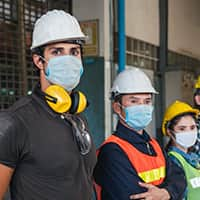COVID-19 Safety Guidelines for Construction
Written by Staff Writer

Even after a global pandemic, COVID-19 has the potential to disrupt day-to-day operations in construction and countless other industries. Workplace safety and health are still crucial to protect workers and maximize efficiency on the jobsite.
Guidelines from the Centers for Disease Control and Prevention (CDC) and public health experts can help reduce the transmission of COVID-19 on construction jobsites. Following health and safety guidelines for the construction industry plays a key role in curbing the spread of the coronavirus and other infectious diseases on the job.
Specific COVID-19 safety guidelines that the CDC recommends for construction workers include:
- Wear a face mask
- Wash your hands frequently
- Cover your face when you cough or sneeze
- Clean and disinfect tools and work surfaces
- Practice social distancing on the jobsite
- Monitor your health
- Stay home when you are sick
By following these guidelines and taking advantage of resources such as the CDC's COVID-19 guide for construction workers, you can stay safe, healthy and productive on the job.
Wear a Face Mask
Wearing a cloth face mask helps prevent the spread of COVID-19 on construction worksites. This precaution is especially important when social distancing is difficult, such as when you need to have a conversation near loud machinery.
Masks are powerful tools for preventing the spread of infectious respiratory diseases. But keep in mind that cloth face coverings are not a substitute for respirators and other personal protective equipment (PPE) required by OSHA.
Wash Your Hands Frequently
By washing your hands or using alcohol-based hand sanitizer regularly, you can protect yourself from COVID-19. The most effective approach is to wash your hands with soap and water for at least 20 seconds, but using hand sanitizer with at least 60% alcohol is also acceptable when you're not near a sink.
According to the CDC, important times to wash your hands include:
- Before and after your work shift or breaks
- After touching tools, equipment or other objects handled by co-workers
- Before you put on work gloves and after you remove them
- After you put on, remove or touch your face mask
- After putting on or taking off eye protection
- Before and after eating
- After using the restroom
- After coughing, sneezing or blowing your nose
In addition to keeping your hands clean, avoid touching your face. With proper hand hygiene, you can prevent yourself and others from getting sick.
Cover Your Face When You Cough or Sneeze
If you need to cough or sneeze while on the job, always cover your face. The CDC recommends to cover your mouth and nose with a tissue and immediately throw it away. If you don't have a tissue, cough or sneeze into your elbow rather than into your hands.
Even if you are wearing your mask when you sneeze or cough, it is best practice for you to cover your face and immediately wash your hands or use hand sanitizer. By engaging in this practice regularly, you can help prevent the spread of COVID-19, the flu and other illnesses.
Clean and Disinfect Tools and Work Surfaces
Because the coronavirus can linger on surfaces, it is imperative to clean and disinfect all items that workers come into contact with often. This includes power tools, surfaces on vehicles and heavy equipment, portable toilet handles and other commonly touched items and work surfaces.
To clean surfaces and tools, use hand sanitizer or an EPA-approved disinfectant on a one-use towel. Avoid tool sharing whenever possible to reduce the risk of spreading the coronavirus. If tool sharing is unavoidable, be sure to clean and disinfect tools before and after each use.
Practice Social Distancing on the Jobsite
The coronavirus and other diseases can become airborne and spread when an infected person coughs, sneezes or talks. To protect yourself and others on the jobsite, the CDC recommends keeping a distance of at least six feet from other people whenever possible.
Monitor Your Health
COVID-19 does not immediately produce symptoms, so you need to be aware of how you are feeling. It's important to notify your supervisor if you are experiencing symptoms. Here are some common symptoms of COVID-19 to look out for.
Symptoms of COVID-19 may include:
- Fever
- Chills
- Loss of taste or smell
- Headache
- Diarrhea
- Sore throat
- Congestion
Visit the CDC website for an up-to-date list of all coronavirus symptoms. If you are experiencing any symptoms of COVID-19 or start to feel ill during the work day, you should immediately notify your supervisor. You should also tell your supervisor if you have come in contact with someone who tested positive for COVID-19.
Stay Home When You Are Sick
If you are experiencing symptoms of COVID-19, you should not go to work. It's important to do your part to prevent the spread of illnesses by staying home when you are sick. That advice applies to other illnesses, as well. Don't share your infection with your coworkers.
Sources
Centers for Disease Control and Prevention. (2020, May 27). Resuming Business Toolkit Coronavirus Disease 2019 (COVID-19). Retrieved from https://www.cdc.gov/coronavirus/2019-ncov/downloads/community/Resuming-Business-Toolkit.pdf
Centers for Disease Control and Prevention. (2020, May 13). Symptoms of Coronavirus. Retrieved from https://www.cdc.gov/coronavirus/2019-ncov/symptoms-testing/symptoms.html
Centers for Disease Control and Prevention. (2020, May 19). What Construction Workers Need to Know about COVID-19. Retrieved from https://www.cdc.gov/coronavirus/2019-ncov/community/organizations/construction-workers.html
Cleveland Clinic. (n.d.). Return to Work Amid COVID-19: A Cleveland Clinic Guide for Manufacturers. Retrieved from https://my.clevelandclinic.org/-/scassets/files/org/employer-solutions/covid-19-manufacturing-guide.ashx
